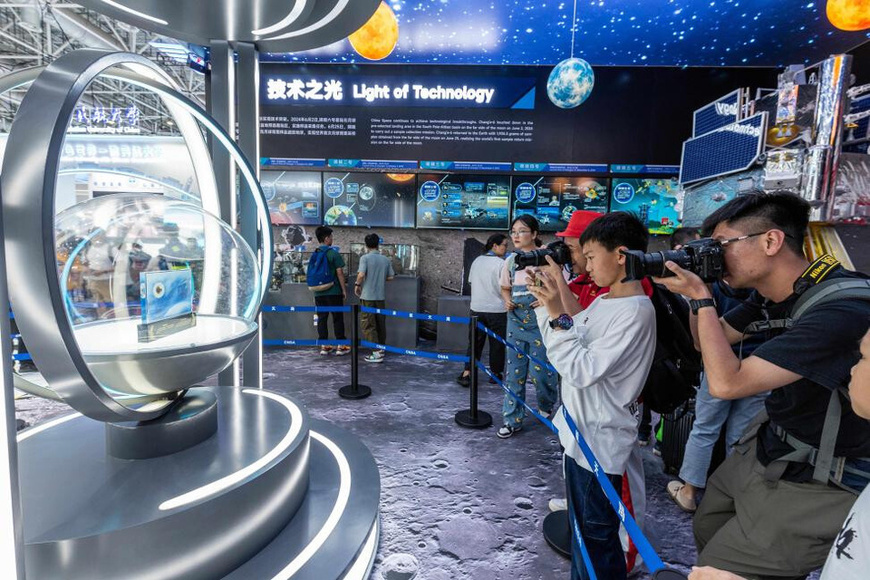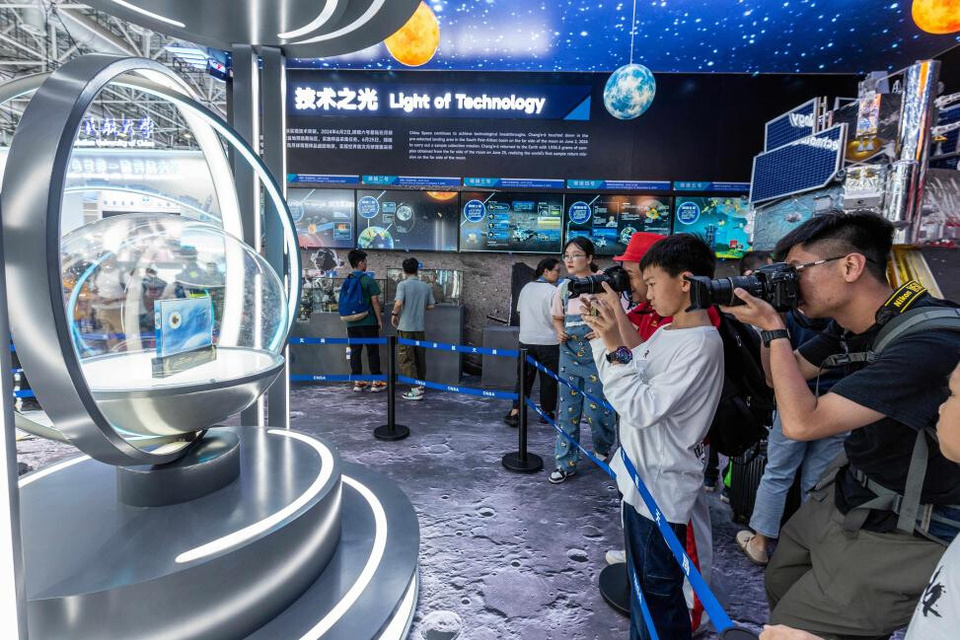By Wu Yuehui, People's Daily

Visitors take photos of lunar samples collected by the Chang'e-6 mission from the moon's far side, on display at the 15th China International Aviation and Aerospace Exhibition in Zhuhai, south China's Guangdong province, Nov. 16, 2024. (Pho'to/Ding Yi)
A series of research findings by Chinese scientists on the samples collected by the Chang'e-6 mission from the moon's far side have unveiled the volcanic activity, ancient magnetic field, water content and geochemical characteristics of the moon mantle, shedding the first light on the evolutionary history of its dark side.
For the first time, researchers found evidence of volcanic activity on the moon's far side approximately 4.2 billion and 2.8 billion years ago, indicating such activity had persisted for at least 1.4 billion years.
Since Chang'e-6 brought lunar far-side samples back to Earth in June 2024, Chinese research teams have made multiple groundbreaking discoveries within just one year. Four of these findings were published in Nature, reflecting a research pace that significantly surpasses comparable international missions.
The driving force behind this rapid progress lies in China's unique organized scientific research model, a structured approach that differs from the traditional "free exploration" method. Tailored to respond to the evolving frontiers of science and technology, this model is designed to address major scientific questions and technical bottlenecks.
By enabling systematic planning, cross-institutional collaboration, and innovative mechanisms, the organized scientific research model breaks down disciplinary boundaries and mitigates fragmented efforts. It integrates high-quality resources, reduces redundancy, and enhances efficiency, making it particularly effective in addressing urgent scientific tasks and advancing core technologies.
During the early planning stages of the Chang'e-6 mission, researchers identified the South Pole-Aitken (SPA) Basin on the moon's far side as the landing site to investigate the long-standing enigma of the asymmetry between the near and far sides. This targeted approach ensured that research efforts remained concentrated and efficient.
During sample analysis, the Chinese Academy of Sciences (CAS) led coordinated efforts with dozens of institutions, including Nanjing University and the China Academy of Space Technology, to foster in-depth interdisciplinary collaboration. Scientists and engineers from diverse fields worked side by side, facilitating the exchange of ideas and the generation of innovative solutions.
One notable example involved a batch of basaltic fragments, which were analyzed by multidisciplinary teams specializing in geochemistry, geology, and geophysics. These teams jointly examined the samples' age, water content, origin, and magnetic properties, demonstrating the collaborative efforts of organized scientific research.
Complementing this organized model was a spirit of scientific exploration. The far side of the moon - long beyond the reach of previous sampling missions - remained a true scientific frontier.
Wu Fuyuan, an academician of CAS and a leading researcher with the Institute of Geology and Geophysics, noted that the far side was completely uncharted territory, with no certainty about what might be retrieved.
"This reverence for the unknown and the fear of missing something important permeated the entire research process," Wu said. Despite numerous uncertainties and formidable challenges, researchers pressed forward with resolve, achieving major breakthroughs that marked a leap from "zero to one."
As a new wave of scientific and technological revolution accelerates, scientific challenges are becoming increasingly complex. The limitations of single-discipline research and isolated efforts have become evident. Solving today's complex scientific issues and major technological challenges requires a broader embrace of organized, collaborative, and interdisciplinary research, guided by frontier trends in science and technology.
The Chang'e-6 mission stands as a testament to the effectiveness of China's organized scientific research model. Its success provides valuable experience for tackling even greater scientific and technological challenges ahead.
For the first time, researchers found evidence of volcanic activity on the moon's far side approximately 4.2 billion and 2.8 billion years ago, indicating such activity had persisted for at least 1.4 billion years.
Since Chang'e-6 brought lunar far-side samples back to Earth in June 2024, Chinese research teams have made multiple groundbreaking discoveries within just one year. Four of these findings were published in Nature, reflecting a research pace that significantly surpasses comparable international missions.
The driving force behind this rapid progress lies in China's unique organized scientific research model, a structured approach that differs from the traditional "free exploration" method. Tailored to respond to the evolving frontiers of science and technology, this model is designed to address major scientific questions and technical bottlenecks.
By enabling systematic planning, cross-institutional collaboration, and innovative mechanisms, the organized scientific research model breaks down disciplinary boundaries and mitigates fragmented efforts. It integrates high-quality resources, reduces redundancy, and enhances efficiency, making it particularly effective in addressing urgent scientific tasks and advancing core technologies.
During the early planning stages of the Chang'e-6 mission, researchers identified the South Pole-Aitken (SPA) Basin on the moon's far side as the landing site to investigate the long-standing enigma of the asymmetry between the near and far sides. This targeted approach ensured that research efforts remained concentrated and efficient.
During sample analysis, the Chinese Academy of Sciences (CAS) led coordinated efforts with dozens of institutions, including Nanjing University and the China Academy of Space Technology, to foster in-depth interdisciplinary collaboration. Scientists and engineers from diverse fields worked side by side, facilitating the exchange of ideas and the generation of innovative solutions.
One notable example involved a batch of basaltic fragments, which were analyzed by multidisciplinary teams specializing in geochemistry, geology, and geophysics. These teams jointly examined the samples' age, water content, origin, and magnetic properties, demonstrating the collaborative efforts of organized scientific research.
Complementing this organized model was a spirit of scientific exploration. The far side of the moon - long beyond the reach of previous sampling missions - remained a true scientific frontier.
Wu Fuyuan, an academician of CAS and a leading researcher with the Institute of Geology and Geophysics, noted that the far side was completely uncharted territory, with no certainty about what might be retrieved.
"This reverence for the unknown and the fear of missing something important permeated the entire research process," Wu said. Despite numerous uncertainties and formidable challenges, researchers pressed forward with resolve, achieving major breakthroughs that marked a leap from "zero to one."
As a new wave of scientific and technological revolution accelerates, scientific challenges are becoming increasingly complex. The limitations of single-discipline research and isolated efforts have become evident. Solving today's complex scientific issues and major technological challenges requires a broader embrace of organized, collaborative, and interdisciplinary research, guided by frontier trends in science and technology.
The Chang'e-6 mission stands as a testament to the effectiveness of China's organized scientific research model. Its success provides valuable experience for tackling even greater scientific and technological challenges ahead.
 Menu
Menu
 Organized research model accelerates breakthroughs in moon's far side
Organized research model accelerates breakthroughs in moon's far side
















